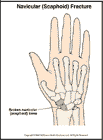
Navicular (Scaphoid) Fracture
What is a navicular or scaphoid fracture?
A navicular fracture is a break in one of the bones in your wrist. The wrist is made up of 8 bones between the forearm and hand. The navicular, or scaphoid, bone is near the thumb. Fractures to this bone sometimes have a healing problem because the bone does not have a good blood supply.
How does it occur?
A navicular fracture is caused by a fall onto your wrist or a direct blow to the bone.
What are the symptoms?
You may have pain, swelling, or tenderness in your wrist, usually just below the thumb.
How is it diagnosed?
Your health care provider will examine your wrist and review your symptoms. An x-ray may show a break in the navicular bone. Sometimes a fracture may not show up in the first x-ray and your provider may recommend a repeat x-ray in 1 to 2 weeks. Sometimes your provider may order a CAT scan or bone scan to confirm the fracture.
How is it treated?
You will need to wear an arm cast that includes your thumb. The cast may or may not extend above your elbow. You will wear the cast for up to 12 weeks or longer to be sure the bone heals.
In some cases healing does not occur and the pieces of bone do not grow back together. This may require surgery.
Sometimes the failure of the pieces of bone to grow back together leads to a problem called avascular necrosis. In avascular necrosis, part of the bone dies because it does not get enough blood. In these cases, an operation is necessary to remove part of the injured bone, insert grafted bone to help heal the fragment, or insert an artificial bone.
Your wrist may heal completely or you may have some permanent stiffness or loss of range of motion.
When can I return to my sport or activity?
The goal of rehabilitation is to return you to your sport or activity as soon as is safely possible. If you return too soon you may worsen your injury, which could lead to permanent damage. Everyone recovers from injury at a different rate. Return to your sport or activity will be determined by how soon your wrist recovers, not by how many days or weeks it has been since your injury occurred.
You may return to your sport or activity when you have full range of motion in your wrist without pain. Your health care provider may allow you to return to competition with your wrist taped or in a brace. Your injured wrist, hand, and forearm need to have the same strength as the uninjured side. You must not have any pain when you do activities such as swinging a bat or a racket or tumbling in gymnastics.
If you return to a sport or activity too soon after a navicular fracture there still could be problems with healing. It is very important to be sure that none of your activities cause wrist pain or tenderness.
How can I prevent a navicular fracture?
A navicular fracture usually occurs during an accident that is not preventable. When you do activities such as skating be sure to wear protective wrist guards.

